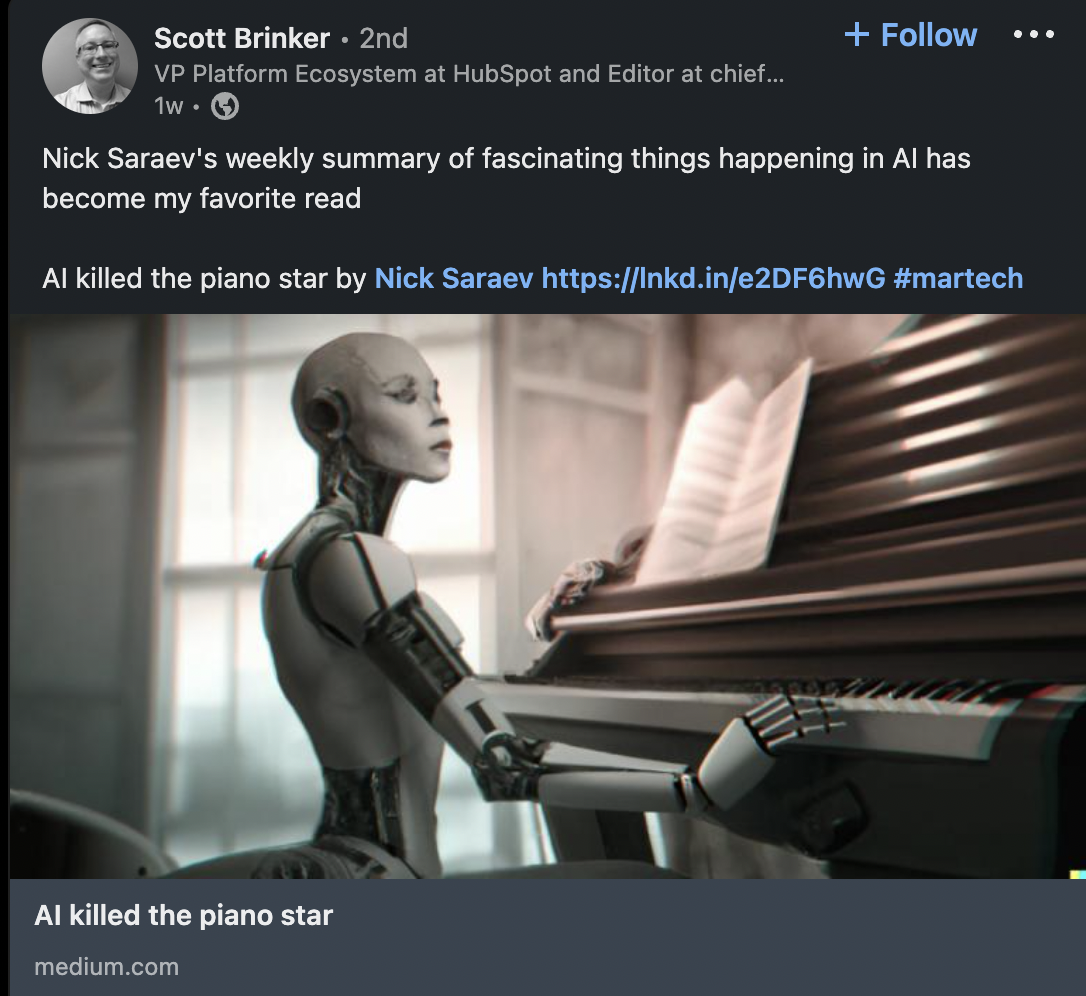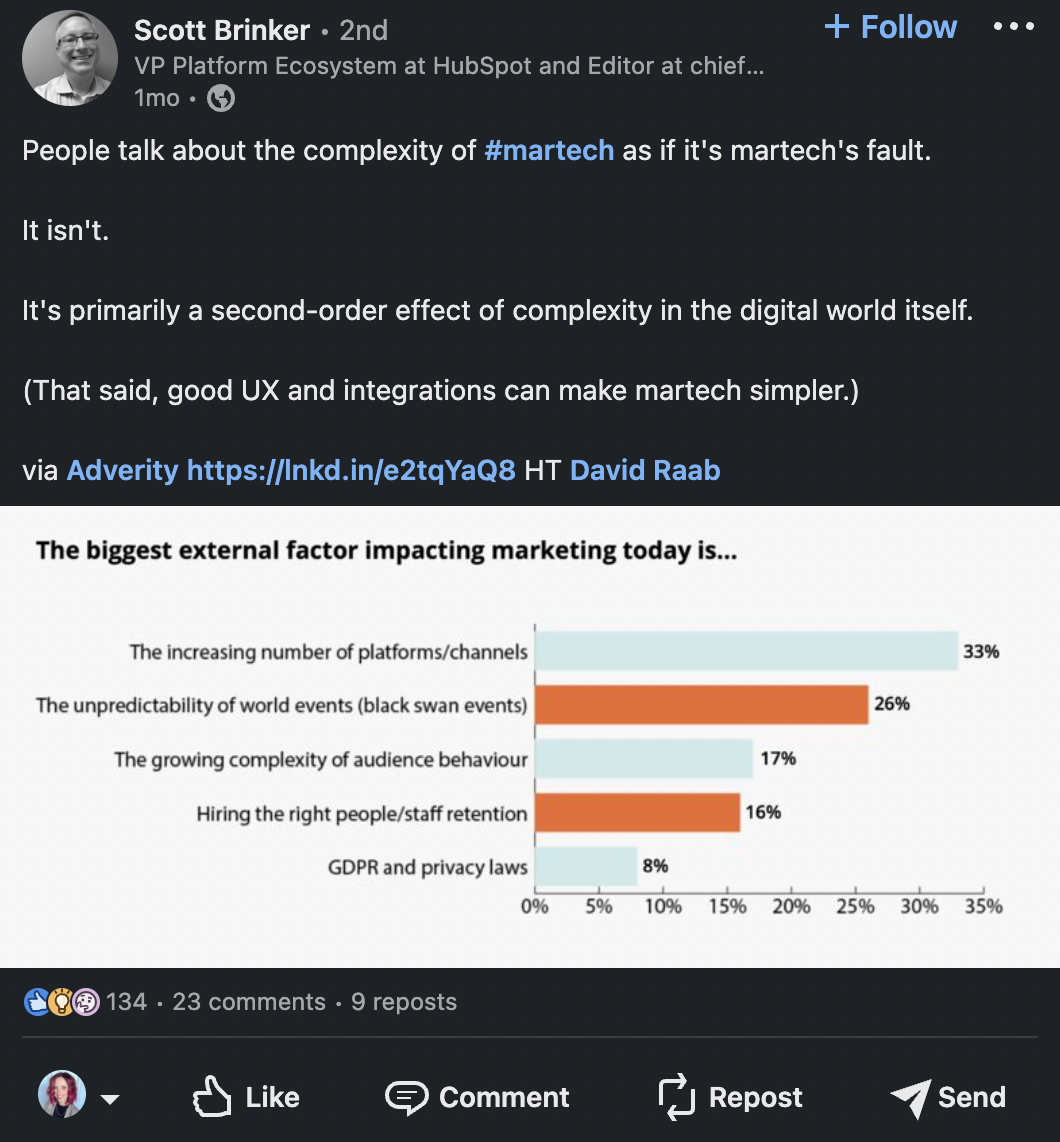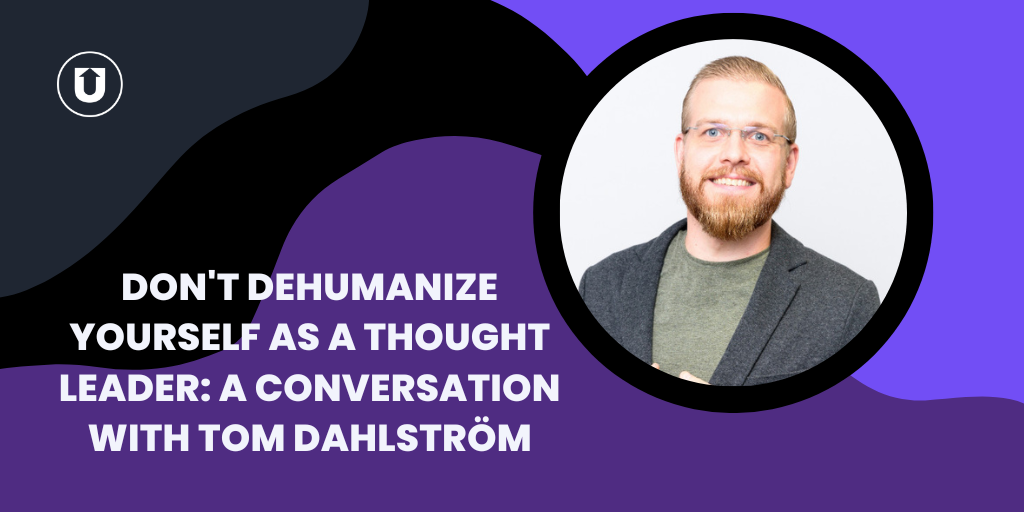Don’t Think So Much About Your Thought Leadership-A Conversation with Scott Brinker
.png?width=2240&height=1260&name=637d2a7159697b634b086bd7_Blog%20Banner%20for%20Website%20Content%20(7).png)
There it is.
The dreaded blinking cursor.
Just blinking away at you while you stare at LinkedIn.
For me, I always get stuck at the beginning.
Once I start writing, it makes more sense…but how do you hook someone into reading and engaging with your post?
According to a LinkedIn survey interviewing 3,600 management-level professionals in sales and marketing, 71% of them say that the thought leadership they read isn’t helpful.
But on the flip side, 65% say that when thought leadership is done right, it can change their perspective on a company.
Here at UpContent, we have helped hundreds of companies develop their thought leadership by sourcing the best third-party content quickly and efficiently, maximizing their time to deepen relationships with their readers.
We sat down with Scott Brinker, Editor at chiefmartech.com and VP of Platform Ecosystem at HubSpot, to find out how he has been able to consistently stay ahead of a rapidly changing industry as one of the preeminent thought leaders in marketing technology.
So what’s the secret sauce?
With over 30,000 followers on LinkedIn, Scott shared that building this community of followers was largely “by accident”. His focus is, and always has been, simply to share his thoughts and opinions on the content he found interesting.
“To be honest, a lot of what I write and what I share starts with me trying to understand what the hell is going on in the world.”
Scott says he uses a lot of his research to aid in the pieces he writes, but he isn’t a fast writer.
“The space that I love is technology. There's so much changing all the time. And I realized for all the effort I put in to dig out what's happening, I'm only scraping the tiniest fraction of it.”
But he reads two to three pieces of curated content per day and, on average is sharing about two pieces of curated content for every original post.
Scott could easily write about anything in his industry and likely see success as he is a leading expert, but he still focuses heavily on sharing other people’s thoughts and expertise.
“I’ve just sort of gotten in the habit of sharing [curated content] to give credit where credit's due, and also like a trial balloon to discover the things [my audience] finds interesting and what they don’t.”

Using a “trial balloon” approach by sharing curated content has helped Scott learn more about what people care about right now, without having to spend the time to write about each area.
Approaching Curation As a “Hot Take”
When asked how much time and thought Scott puts into thinking about his curated perspective of content he shares, he says it’s not a super thought-out process.
“I would say curated perspective is overstating the case. A closer term to what I do would be a ‘hot take’. I try to attach something like, ‘Why did I find this interesting? Or why did I endorse this article?’ But I don't give more than 30 seconds of thought to that.” he says.

If you’re not used to writing or get afraid of the blinking cursor, your commentary on a curated article doesn't need to be your Shakespearean novella.
Why did you find the content interesting? How did it change your perspective? Just be authentic about your thoughts.
Stop Trying To Be Someone You’re Not
Some of the best thought leaders out there are the ones we feel are most human, wouldn’t you agree?
Over the last 15 years that Scott has been sharing third-party content and creating his own content, he says it can be overwhelming if there isn’t individual personality mixed in.
“I feel like there's a blend of two things that resonates with people. One is bringing facts or data to the table and the second is being human. I've tried to inject more of my personality and my bizarre sense of humor into these things,” Scott says.
Scott says that with fast-moving industries such as marketing technology, thought leadership is often more of a collective knowledge.
We can directionally feel where the masses are moving, but there is no known map of where things are going - so we are all exploring new trends and challenges as an industry and sharing these perspectives with one another.
That’s where being yourself, having comradery, and open discussion can help us all move forward together.
“It's so complex and challenging in so many ways that we need to have a little bit of fun to make our way through it. But if it's too dry, no one will want to engage with that,” remarks Scott.
Sometimes we take ourselves too seriously, right?
We try to portray ourselves as someone we're not and end up finding out that the people we want to be engaging with are the ones who also want to engage with us as the person that we are, not just some stoic store of knowledge.
If you read any of Scott’s work, you can’t but help hear him narrating in your mind and feel that you are being drawn into the conversation.
Why? Because more often than not, soliciting the feedback of his audience to determine the validity of a finding, add color to a hypothesis, or simply share an experience is exactly what Scott is after.
There’s no hidden pitch. No gaming the system through a seemingly infinite number of hard returns. Just an exchange of ideas and perspectives - and it shows.
Content First, Publisher Second
It can be easy when sharing third-party content to get hung up on where the content came from, but only caring to consume content from well-known publishers can blind us from truly unique, engaging, and possibly more accurate perspectives.
Scott also shared that he believes in content first and author/publisher second when evaluating the “worth” of a piece of content.
So many great minds are sharing their thoughts, data, and opinions now that being caught up on certain platforms can limit your perspective.
“If [the author does] a great job of actually explaining the problem, or even explaining what they think the solution is, I find those things fascinating,” Scott says.
Not being concerned about who's writing stuff will expose you to more opinions, especially if it's in a fast-moving environment where the staple publishers may not be the thought leaders anymore.
Maybe there's an up-and-comer you’re missing out on who's writing really interesting, unique perspectives because perhaps they don't have all the shackles or a more “mainstream publication”.
Continuing the conversation
“I think one of the things I was traditionally quite bad at was I wouldn't pick up the conversation after sharing the initial thought,” Scott says.
Once Scott started engaging with people commenting on his post, he started getting even more from his unintentional thought leadership, and his posts took on a life of their own.
“I feel like the environment has changed now where on LinkedIn, I'm finding the discussions that sometimes happen around these pieces are actually really interesting.”
Being the same human online as you are in your desk chair will take you, your content, and your thought leadership to the next level - while also assembling a community and following that allows you to remain authentic in that relationship.
Don’t overthink what you’re saying.
Communicating your reaction in a way YOU would say it, and sharing good content regardless of publisher will help you start, grow, and continue the conversation in your industry.
Download Scott Brinker's Four Keys To Authentic Thought Leadership for easy reference as you continue growing in your thought leadership!
If you’re interested in learning more about how you can use curated content in your thought leadership efforts, check out some of these articles below!



